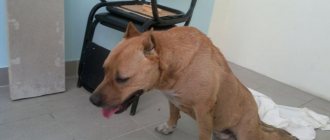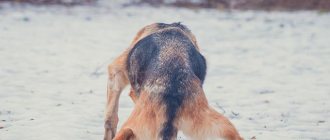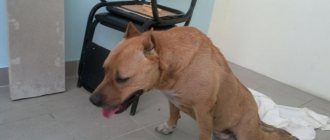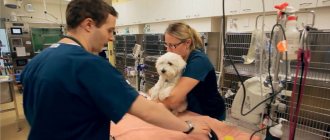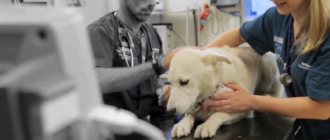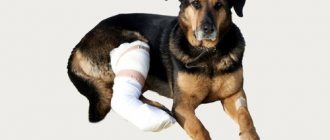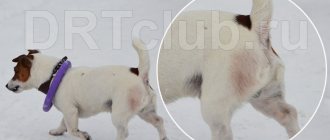Today I will talk about why some dogs may experience back leg failure. I will consider possible pathological processes, their causes, how they manifest themselves and which breeds are predisposed. I’ll tell you what to do and how to cure it with folk remedies if the dog cannot get up and its paws are taken away. This will cover the issues of preventing spinal diseases.
Explicit and implicit symptoms
Obvious symptoms are characterized by a rapid course. They appear along with pain and weakness in the limbs. It becomes difficult for the animal to make habitual movements, and soon the legs lose sensitivity. Loss of response to a stimulus is the most alarming sign, called paresis. When their legs fail, old dogs fall and turn their heads to the side. Because of fear, they completely lose coordination and their breathing quickens.
The sequential occurrence of the listed symptoms lasts no more than a day. The condition worsens not only with physical activity, but also during sleep. Sudden movements in this situation are provoking factors, not the real reasons.
It is almost impossible to recognize the disorder at the initial stage, since the initial symptoms are difficult to diagnose. Possible subtle
symptoms include:
- loss of activity and rapid fatigue;
- lack of strength to move after a long sleep with subsequent restoration of mobility during the day;
- unsteady gait with limping or dragging legs;
- the occurrence of clicking in the joints while walking;
- refusal to go up or down stairs;
- wobbling of the butt under intense loads.
A sick dog shows anxiety and is reluctant to respond to the owner’s call. Due to the intermittent pain that occurs only with sudden movements, he tries to remain motionless for as long as possible.
How to help an animal
The ideal solution would be to find a really kind and caring veterinarian who will not dismiss it and send your pet to be euthanized, but will recommend appropriate treatment.
Try to partially restore your pet's strength and performance with the help of medications. Carry out a course of treatment with injections of the drug Milgamma. The drug includes a complex of B vitamins, which improves nerve conduction and is effective for all kinds of polyneuropathies. The drug is administered 1 ml once a day for 7 days.
The drug Cerebrolysin, which is injected subcutaneously into the dog for 10 days twice a day, has a good effect. For oral administration, give the dog Traumatin and Chondartron for 1-2 weeks.
Veterinarians recommend giving an elderly pet the drug Gamavit intravenously for 2 days, then continuing to inject 10 ml into the withers for an additional week. The drug is painful, the animal may whine or snap. However, it is effective even for elderly pets.
Within 5 days, inject the four-legged animal under the skin of the withers with 5 ml of emicidin.
If a positive effect is noted, it is possible to continue Gamavit injections for up to 10 days.
If it is impossible to administer drugs intravenously, inject under the skin on the withers and back.
Causes of the disease
If a dog's hind legs fail, the causes are injuries, pathologies of the spinal column, viral infections and urolithiasis (UCD). Dogs involved in an accident are always under supervision, so it is easier for their owners to detect violations. In other cases, a sudden deterioration in health comes as a real surprise.
Injuries
Limb injuries occur after car accidents, falls from high surfaces, fights or active games with other dogs, and even when making an unsuccessful turn while running. Depending on the severity of the injury, the dog's bones are broken, nerves are compressed, and tendons are torn or stretched.
The most dangerous are bruises of the spine, accompanied by swelling. Due to constant pressure from the resulting edema in the spinal cord, blood circulation is disrupted. As a result, the nerve cells die and stop sending signals to the legs.
Diseases of the musculoskeletal system and central nervous system
Most often it paralyzes the chest or lower back. This occurs under the influence of 6 diseases.
Dysplasia
The disease is inherited and often affects large breeds during puppyhood. During rapid growth, which occurs in 4-10 months, the sick animal's joint tissue becomes thinner and bone structures become deformed. The most common type of dysplasia is the hip, since it is this department that bears the main load.
When buying a large breed puppy, be sure to ask the breeder for a certificate of the health of the joints of both parents.
Arthrosis and arthritis
Both pathologies are characterized by destruction of articular and cartilage tissues. Due to extreme wear and tear, the pet experiences severe pain. As a result, the limbs become “wobbly” and interfere with normal lifting.
Arthritis differs from arthrosis in the condition of its occurrence. Arthritis develops against the background of an inflammatory process, while arthrosis is the result of damage to cartilage tissue. The development of both diseases is facilitated by excess or lack of physical activity, obesity, hypothermia, injury and poor nutrition.
The risk group includes older dogs. The disease cannot be eliminated entirely, so therapy is aimed at slowing its development and relieving the symptoms.
Discopathy
If your pet is paralyzed from discopathy, then the process is very advanced. An alternative name for this pathology is intervertebral hernia. It occurs in the sacrum or lower back when discs become displaced or ruptured. As a result, shock absorption during spinal oscillation is reduced.
“
Discopathy is characterized by long-term development with gradual disruption of the spinal cord. As a result, the animal develops more and more obvious symptoms and its legs suddenly fail.
Osteochondrosis
Osteochondrosis often appears as a consequence of discopathy and deforms the vertebral cartilage. The spinal column becomes overfilled with minerals and ossifies. These changes destroy the joints. Pathology occurs with mechanical damage, obesity, autoimmune diseases, improper feeding and congenital anomalies. Small breeds are at risk.
Spondylosis
The pathology is typical for older dogs. It develops along with local wear and tear of the spinal segments. Weakened structures do not cope well with their function, therefore, under the influence of degenerative changes, osteophytes - bone growths - appear on the spinal column.
Over time, the lumbar region loses its mobility. When the nerve roots are pinched, the lower part of the body is paralyzed. Spondylosis is characterized by slow development and a long absence of pain.
Spinal tumors
Neoplasms that appear on the spinal column cause tissue swelling, compress nerve endings and deform cartilage. This is accompanied by acute and sharp pain when touching the back, during games and when changing body position.
Viruses
The risk group includes unvaccinated pets. If they come into contact with carriers of the virus, they can become infected with rabies or canine distemper. These diseases impair coordination and are accompanied by seizures. The infected person develops a fever, causing him to shiver with fever. Vomiting and diarrhea are also added to the symptoms.
Urolithiasis disease
Stones in the bladder are formed due to a small amount of fluid consumed, congenital bends of the organ, poor nutrition and other pathological factors. The lower spine is directly related to urination, so chronic pathologies affect its condition.
What diseases cause paralysis?
In dogs, paresis of the hind legs (partial loss of sensation) or paralysis (complete loss of mobility) causes diseases that can develop unnoticed for a long time. Among these causes are injuries, degenerative diseases of the spine and joints, and neurological pathologies.
The inability to stand on your paws is the final symptom. It indicates the transition of the defect to the final stage of development, which is difficult to stop. Paralysis usually occurs suddenly: in the morning the dog was happily running around, but a few hours later it lies down and refuses to get up.
Physical damage
Various injuries lead to damage to joints, bones, tendons, and nerves. Injuries to the spine are especially dangerous - they change the integrity of the structure and cause swelling, which puts pressure on the spinal cord and disrupts innervation.
The dog can get hurt during:
- active games;
- fights with relatives;
- car accidents – a dog can be hit by a car if it is walking unattended;
- falls from a height - and the elevation does not have to be large; small breeds (toy terriers, Yorkies) are often injured when jumping from sofas, tables, armchairs;
- sharp turn while running.
The most favorable outcome is if the pet simply injured its paw or its pad. In this case, he will be restless, whine when he sits down, limp or drag a limb.
Dragging paws in puppies or pregnant females
The puppy drags its paws due to congenital pathologies (cerebral palsy), rickets or muscle underdevelopment. Muscle atrophy occurs when kept in cramped conditions and lack of body movement. The appearance of rickets is influenced by early weaning or underfeeding.
“If congenital defects cannot be treated and can only be corrected, then rickets and atrophy can be completely stopped.
Complications of movement are also typical for pregnant females. This occurs due to too many and too many puppies. Also, the pet may drag its paws shortly before giving birth, immediately after the onset of contractions. These conditions are not dangerous to health, but in order to exclude possible pathologies, it is better to undergo an examination at a veterinary clinic.
Answer
Old dogs get tired easily, sleep a lot, move little, rarely play and have difficulty hearing. An elderly pet does not please the owner with energy and enthusiasm. An old dog finds a secluded, cozy corner in which he can lie all day. The character becomes capricious and touchy, the dog is able to not respond to the owner’s call.
Unfortunately, pets age faster than their owners want. The onset of old age depends on the breed and size of the animal. Often dogs become old at 10 years old, but with proper care and care they live to be 20. Sometimes veterinarians advise euthanizing an old dog. The decision to euthanasia depends on the situation. You should help the animal live a long time and please its owners with your love.
Breeds at risk
The risk group includes breeds that have undergone strict selection in order to improve their decorative and working qualities. These include brachycephalics (bulldogs, boxers, pugs, sharpeis) and animals with a long spinal column (bassets, dachshunds). Representatives of large and giant breeds are also vulnerable to paralysis: Great Danes, Labradors, St. Bernards, Shepherds, Alabais.
When buying a puppy, check its parents for dysplasia - to do this, ask the breeder for the appropriate certificates. Independent research regarding your pet's health can only be done after 1 year.
Treatment and help for the dog
If your four-legged pet’s paws have lost or just started to fail, sign up for a veterinary clinic. A veterinary neurologist treats such pathologies.
At home
The only effective help is rapid transportation to the nearest clinic. If you suspect a spinal injury, avoid sudden shifting. The animal will have to be carefully placed on the board and secured with straps or bandages. Do not give painkillers even if the pain is severe. Feeling light, the dog will try to make a movement, which will lead to even greater displacement of the vertebrae and complicate the diagnosis.
Under the guidance of a veterinarian
Before starting treatment, it is necessary to determine the reason why the dog’s hind legs are failing. To do this, the doctor evaluates reflexes and pain reactions, does x-rays, MRI and myelography. Changes in general indicators are assessed using blood and urine tests. Depending on the diagnosis, the veterinarian offers 2 treatment options: medication and surgery.
Drug therapy is aimed at eliminating pain, accelerating the healing of damaged tissue and preventing complications. Most animal drugs duplicate human ones. Patients are prescribed:
- non-steroidal anti-inflammatory drugs (NSAIDs);
- vitamin complexes and immunomodulators;
- antispasmodics;
- painkillers.
Damaged cartilage tissue is restored with the help of chondroprotectors. At an early stage of the disease, physiotherapy is effective. The animal is prescribed sessions of acupressure and warming with a blue lamp, as well as acupuncture.
Surgery
In case of severe injuries, advanced stage of discopathy and the presence of formations, surgery is performed. The dog has pins and plates placed to safely fuse the bones, or damaged discs are replaced with artificial implants.
After surgery, the animal is prescribed a course of antibiotics and anti-inflammatory drugs. This prevents the risk of infection of the sutures.
What not to do
Not all owners know what not to do if their dog’s hind legs fail. Because of this, the problem gets worse, and the veterinarian has to deal with the complications that have arisen.
“A sick animal should not be forced to move. Transport it directly in your arms or call a taxi.
It is also prohibited to massage the vertebrae and limbs or apply a heating pad or ice to the affected areas. These actions are permissible only after the root cause has been clarified and only as directed by the attending physician.
What to do if your dog's back legs fail
First of all, go to the vet.
When considering possible pathologies, treatment is completely different, and independent therapy will lead to dire consequences.
The veterinarian will prescribe an x-ray of the pelvic limbs and spine, which will show pathologies of the paws and spine.
Only an experienced veterinarian can treat the disease.
Caring for a pet with paralysis
During the rehabilitation period, avoid traditional medicine. Natural components often cause allergic reactions and are ineffective outside of complex therapy.
Review your diet, making it easily digestible and fortified. The main emphasis is on calcium and B vitamins. Eliminate any foods that cause fermentation - legumes, baked goods, unprocessed cabbage, spinach, apples, mushrooms and dried fruits. Due to flatulence, pain worsens, so it is more difficult for the pet to survive the healing of wounds left after surgery, if any.
Wash your pet regularly to prevent bedsores and unpleasant odors. At first it will be difficult for him to get to the toilet, so lay out disposable diapers and regularly change his sleeping place. With timely treatment, the prognosis is favorable, and the lost movement function gradually returns.
Symptoms
Usually, owners quickly notice that the animal is not in order. If there was an injury, then the dog most often simply stops getting up on its paws immediately or the next day.
If the disease develops gradually, symptoms may more often manifest themselves in behavior:
- The dog is reluctant or takes a long time to get up after sleep
- A previously active and playful dog ceases to be interested in walks, favorite toys, and outdoor games.
- Change in gait: the dog drags its paws, walks more slowly, or its gait loses its natural harmony and grace
- Sometimes the dog may yelp or whine. This happens when stroking, leaning on a sore paw, or walking.
- The dog is slouching, hunching over
- In severe cases, involuntary urination may additionally occur.
